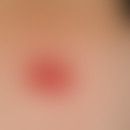DefinitionThis section has been translated automatically.
Lymphoproliferative syndrome type 2, also known as CD27 deficiency syndrome - LPFS- is an autosomal recessive immunodeficiency disease caused by a homozygous mutation in the CD27 gene (186711) on chromosome 12p13.
The immunodeficiency syndrome is associated with persistent symptomatic EBV viremia, hypogammaglobulinemia, and impaired specific antibody function. This results from impaired T cell-dependent B cell response and T cell dysfunction. (see van Montfrans et al. 2012).
The phenotype can vary considerably, from asymptomatic, borderline low hypogammaglobulinemia to a full-blown symptomatic systemic inflammatory response with life-threatening EBV-related complications, including hemophagocytic lymphohistiocytosis, a lymphoproliferative disorder, and malignant lymphoma (Salzer et al. 2013).
ManifestationThis section has been translated automatically.
Early Childhood (Van Montfrans et al. 2012).
Case report(s)This section has been translated automatically.
Van Montfrans et al (2012) reported a 21-year-old man of Moroccan descent, born of consanguineous parents, with combined immunodeficiency and persistent symptomatic EBV viremia since early childhood. He presented at 2.5 years of age with fever, lymphadenopathy, hepatomegaly, and EBV seroconversion. Immunoglobulins were initially elevated but fell below normal after clinical symptoms resolved. After 6 months, Ig substitution therapy was initiated, and the patient has since had an unremarkable medical history. T-cell proliferation tests initially showed greatly reduced mitogen- and antigen-specific responses, which gradually increased to subnormal and normal levels, respectively, during the following year. Immunologic examination revealed a complete absence of CD27+ on all lymphocytes, although normal naive T cells and switched IgG+ and IgA+ B cells were present. T-cell-dependent B-cell responses were decreased in vivo and in vitro. In vitro studies demonstrated an impaired proliferative T-cell response to mitogens that are highly dependent on CD27 (e.g., CD2; 186990), although proliferative responses were detected against a variety of recall antigens. Family history revealed an older brother with EBV-induced lymphadenopathy, fever, hepatosplenomegaly, and uveitis. This patient lacked T-cell responses to mitogens and antigens. He eventually developed aplastic anemia and died in infancy. Van Montfrans et al (2012) pointed out the phenotypic similarities with combined variable immunodeficiency (CVID; 607594).
Seidel (2012) reported a girl from a Viennese family of Turkish origin who presented with EBV-associated hemophagocytic lymphohistiocytosis (HLH) syndrome at 17 months of age, two months after developing infectious mononucleosis. Clinical features included fever, pancytopenia, organomegaly, and decreased fibrinogen. She had a systemic inflammatory response with lymphoproliferative disorder (LPD) and hypogammaglobulinemia. Treatment with high-dose steroids resulted in transient stability. The patient's B lymphocytes did not express CD 27. She had several more relapses of the lymphoproliferative disorder that responded well to rituximab (anti-CD20 antibody). Low-grade EBV viremia persisted.
Salzer et al (2013) reported on two consanguineous Lebanese families with LPFS2. In one family, a 4-year-old boy presented at 18 months of age with EBV-associated lymphoproliferative disease and HLH. Although immunoglobulin levels were initially normal, he later became hypogammaglobulinemic. He was treated with rituximab. His younger sister was diagnosed with lack of CD27 expression and EBV infection only after her brother was found to be CD27 deficient. In the other family, the proband was a 19-year-old boy who presented with EBV-LPD at age 15. He responded to rituximab, but EBV viremia recurred 3 months later. At the time of diagnosis, he was hypergammaglobulinemic, but immunoglobulin levels slowly decreased. Later, he was diagnosed with T-cell lymphoma that required treatment with rituximab and chemotherapy. Two older sisters died at the ages of 2 and 22 years from what was thought to be EBV-related lymphoma.
LiteratureThis section has been translated automatically.
- Cohen JI (2015). Primary immunodeficiencies associated with EBV disease. Curr Top Microbiol Immunol 390:241-265.
- Salzer E et al (2013) Combined immunodeficiency with life-threatening EBV-associated lymphoproliferative disorder in patients lacking functional CD27. Haematologica 98: 473-478.
- Seidel MG (2012) CD27: a new player in the field of common variable immunodeficiency and EBV-associated lymphoproliferative disorder? (Letter) J Allergy Clin Immun. 129: 1175.
- van Montfrans J et al. (2012) CD27 deficiency is associated with combined immunodeficiency and persistent symptomatic EBV viremia. J Allergy Clin Immun 129: 787-793.
Disclaimer
Please ask your physician for a reliable diagnosis. This website is only meant as a reference.



